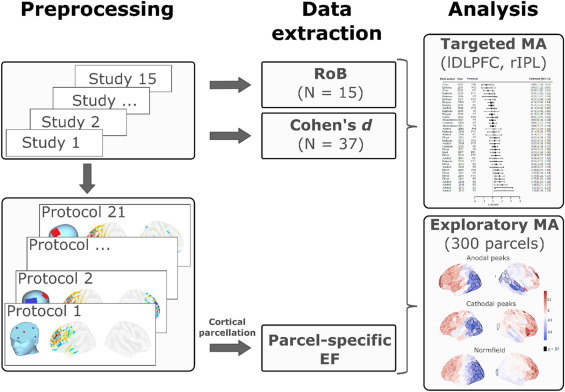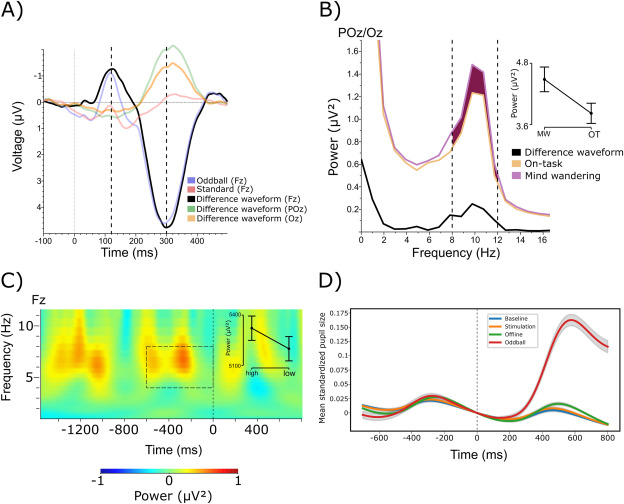In our research, we focus on non-invasive brain stimulation to understand and potentially modulate mind wandering, with a particular emphasis on clinical applications, such as for ADHD. Committed to Open-Science principles, our team rigorously follows best methodological and statistical practices, including pre-registered reports, ensuring transparency in our findings. Exploring both electrical and magnetic stimulation techniques, our work aims to offer insights into cognitive regulation. By maintaining a balanced approach between innovation and adherence to high research standards, we hope to contribute valuable knowledge that may one day translate into practical benefits for clinical populations dealing with attention-related challenges.
 |
We conducted a meta-analysis on all studies using electric brain stimulation (a specific method called tDCS) and how they affected mind-wandering. We used computational models to quantify how strong the stimulation affected different brain areas. We found that the effects of the stimulation were very inconsistent and disappeared when better methods were used. Nawani, H., Mittner, M. & Csifcsák, G. (2023). Modulation of Mind Wandering Using Transcranial Direct Current Stimulation: A Meta-Analysis Based on Electric Field Modeling. NeuroImage. , pp. 120051 doi:10.1016/j.neuroimage.2023.120051 |
 |
In a rigorous replication of a study that initially found effects of brain stimulation on mind wandering, we were unable to detect such an effect. Our results are supported by neural data (electroencephalography, EEG) showing that participants used specific brain areas to process during experiment.
|
 |
In a large study that was conducted across three labs in three countries, we provided conclusive evidence that a brain-stimulation protocol that was previously established for modulating mind wandering is, in fact, not affecting mind wandering at all. Boayue, N., Csifcsák, G., Aslaksen, P., Turi, Z., Antal, A., Groot, J., Hawkins, G., Forstmann, B., Opitz, A., Thielscher, A. & Mittner, M. (2019). Increasing Propensity to Mind-Wander by Transcranial Direct Current Stimulation? A Registered Report. The European Journal of Neuroscience. doi:10.1111/ejn.14347 |
Publications
- Nawani, H., Mittner, M. & Csifcsák, G. (2023). Modulation of Mind Wandering Using Transcranial Direct Current Stimulation: A Meta-Analysis Based on Electric Field Modeling. NeuroImage. , pp. 120051 doi:10.1016/j.neuroimage.2023.120051
- Alexandersen, A., Csifcsák, G., Groot, J. & Mittner, M. (2022). The Effect of Transcranial Direct Current Stimulation on the Interplay between Executive Control, Behavioral Variability and Mind Wandering: A Registered Report. Neuroimage: Reports. 2:3, pp. 100109 doi:10.1016/j.ynirp.2022.100109
- Kam, J., Mittner, M. & Knight, R. (2022). Mind-Wandering: Mechanistic Insights from Lesion, tDCS, and iEEG. Trends in Cognitive Sciences. 0:0 doi:10.1016/j.tics.2021.12.005
- Boayue, N., Csifcsák, G., Kreis, I., Schmidt, C., Finn, I., Vollsund, A. & Mittner, M. (2020). The Interplay between Executive Control, Behavioral Variability and Mind Wandering: Insights from a High-Definition Transcranial Direct-Current Stimulation Study. European Journal of Neuroscience. doi:10.1111/ejn.15049
- Boayue, N., Csifcsák, G., Aslaksen, P., Turi, Z., Antal, A., Groot, J., Hawkins, G., Forstmann, B., Opitz, A., Thielscher, A. & Mittner, M. (2019). Increasing Propensity to Mind-Wander by Transcranial Direct Current Stimulation? A Registered Report. The European Journal of Neuroscience. doi:10.1111/ejn.14347
[Loading...]